Spatiotemporal Characteristics of Drought in Northwest China Based on SPEI Analysis
Abstract
1. Introduction
2. Overview and Explanation of Data
2.1. Overview of the Study Area
2.2. Data Sources
2.3. Research Methods
2.3.1. Standardized Precipitation Evapotranspiration Index (SPEI)
2.3.2. Interpolation Calculation of P and ET0
- (1)
- If less data was missing, two conditions existed. When the missing sequencing column was less than 5d, the linear interpolation of recent days’ data was used to interpolate. When 5d < missing sequencing column < 30d, the multi-year average of the same day was used to interpolate [23]. Here, the Penman–Monteith formula (ET0PM) was also used to calculate the ET0 [24].
- (2)
- If longer series data were missing, the Penman–Monteith formula cannot be used. By this time, the ET0 can be calculated using the formula ET0D provided by FAO56 based on the absence of sunshine hours, relative humidity, and/or wind speed [24]. Firstly, the ET0PM and ET0D sequences were obtained by using the two formulas. Then, Equation (7) was obtained by linear fitting, and the ET0 was calculated accordingly.
- (3)
- According to the geographical similarity hypothesis, the closer the geographical distance, the more similar the meteorological conditions of the stations. The interpolation processing of the data was carried out in our study.
2.3.3. Spatiotemporal Analysis of Drought Index
Climate Tendency Rate
Drought Evaluation Index Calculation
- (1)
- The Pi was used to evaluate the frequency of drought in a station during the years with available data, which was calculated by the following equation:
- (2)
- The Sij was used to evaluate the severity of drought occurring in a region, which was calculated as follows:
- (3)
- The Pj was used to evaluate the size of the influence area of drought, which was calculated by the proportion of the number of drought stations in the total number of stations.
Mann–Kendall Mutation Test
Wavelet Analysis
Spatial Interpolation Method
3. Results and Discussion
3.1. Spatial Distribution of Climate Tendency Rate of SPEI in Northwest China
3.2. Spatial Analysis of Drought Frequency at SPEI Annual Scale in Northwest China
3.3. SPEI and Drought Temporal Pattern in Northwest China
3.3.1. Analysis of Annual SPEI and Drought Time Pattern
3.3.2. Periodicity of Annual SPEI and Drought
3.4. Shortage and Prospect of the Present Study
4. Conclusions
Author Contributions
Funding
Institutional Review Board Statement
Informed Consent Statement
Data Availability Statement
Conflicts of Interest
References
- Samantaray, A.K.; Ramadas, M.; Panda, R.K. Changes in drought characteristics based on rainfall pattern drought index and the CMIP6 multi-model ensemble. Agric. Water Manag. 2022, 266, 107568. [Google Scholar] [CrossRef]
- Wu, Z.; Yu, L.; Du, Z.; Zhang, H.; Fan, X.; Lei, T. Recent changes in the drought of China from 1960 to 2014. Int. J. Climatol. 2020, 40, 3281–3296. [Google Scholar] [CrossRef]
- Hou, H.; Peng, S.; Xu, J.; Yang, S.; Mao, Z. Seasonal variations of CH4 and N2O emissions in response to water management of paddy fields located in southeast China. Chemosphere 2012, 89, 884–892. [Google Scholar] [CrossRef]
- Wu, M.; Li, Y.; Hu, W.; Yao, N.; Liu, D.L. Spatiotemporal variability of standardized precipitation evapotranspiration index in mainland china over 1961–2016. Int. J. Climatol. 2020, 40, 4781–4799. [Google Scholar] [CrossRef]
- Won, J.; Choi, J.; Lee, O.; Kim, S. Copula-based Joint Drought Index using SPI and EDDI and its application to climate change. Sci. Total Environ. 2020, 744, 140701. [Google Scholar] [CrossRef]
- Faiz, M.A.; Zhang, Y.; Zhang, X.; Ma, N.; Aryal, S.K.; Ha, T.T.V.; Baig, F.; Naz, F. A composite drought index developed for detecting large-scale drought characteristics. J. Hydrol. 2022, 605, 127308. [Google Scholar] [CrossRef]
- Ghasemi, P.; Karbasi, M.; Zamani Nouri, A.; Sarai Tabrizi, M.; Azamathulla, H.M. Application of Gaussian process regression to forecast multi-step ahead SPEI drought index. Alex. Eng. J. 2021, 60, 5375–5392. [Google Scholar] [CrossRef]
- Shi, X.; Yang, Y.; Ding, H.; Chen, F.; Shi, M. Analysis of the variability characteristics and applicability of SPEI in mainland China from 1985 to 2018. Atmosphere 2023, 14, 790. [Google Scholar] [CrossRef]
- Bae, S.; Lee, S.H.; Yoo, S.H.; Kim, T. Analysis of drought intensity and trends using the modified SPEI in south Korea from 1981 to 2010. Water 2018, 10, 327. [Google Scholar] [CrossRef]
- Yang, Y.; Gan, T.Y.; Tan, X. Spatiotemporal changes of drought characteristics and their dynamic drivers in Canada. Atmos. Res. 2020, 232, 104695. [Google Scholar] [CrossRef]
- Wu, J.; Tan, X.; Chen, X.; Lin, K. Dynamic changes of the dryness/wetness characteristics in the largest river basin of South China and their possible climate driving factors. Atmos. Res. 2020, 232, 104685. [Google Scholar] [CrossRef]
- Cao, S.; Zhang, L.; He, Y.; Zhang, Y.; Chen, Y.; Yao, S.; Yang, W.; Sun, Q. Effects and contributions of meteorological drought on agricultural drought under different climatic zones and vegetation types in Northwest China. Sci. Total Environ. 2022, 821, 153270. [Google Scholar] [CrossRef]
- Yang, P.; Zhang, S.; Xia, J.; Chen, Y.; Zhang, Y.; Cai, W.; Wang, W.; Wang, H.; Luo, X.; Chen, X. Risk assessment of water resource shortages in the Aksu River basin of northwest China under climate change. J. Environ. Manag. 2022, 305, 114394. [Google Scholar] [CrossRef] [PubMed]
- Jiang, Y.; Zhang, L.; Zhang, B.; He, C.; Jin, X.; Bai, X. Modeling irrigation management for water conservation by DSSAT-maize model in arid northwestern China. Agr. Water Manag. 2016, 177, 37–45. [Google Scholar] [CrossRef]
- Guo, G.; Yang, F.; Wu, R. Analysis on advantage of developing Melon crops with arched shed in Hetao area. Inn. Mong. Agric. Sci. Technol. 2015, 43, 127–128. [Google Scholar]
- Chen, G.; Yang, G.; Zhao, M.; Wang, L.; Wang, Y.; Xue, J.; Gao, J.; Li, D.; Dong, S.; Li, C.; et al. Studies on maize small area super- high yield trails and cultivation technique. J. Maize Sci. 2008, 16, 1–4. [Google Scholar]
- Tian, L.; Zhao, D.; Abdul, K.; Cui, J.; Xu, H.; Guo, R.; Lin, T. Climatic analysis of cotton region of Uzbekistan and Xinjiang. Cotton Sci. 2014, 36, 3–11. [Google Scholar]
- Liu, H. Study on mechanism and regulation of soil water-salt-nutrient movement under drip irrigation of grape in saline land. Shihezi Univ. 2018. [Google Scholar]
- Liang, C.; Yu, S.; Zhang, H.; Wang, Z.; Li, F. Economic evaluation of drought resistance measures for maize seed production based on TOPSIS model and combination weighting optimization. Water 2022, 14, 3262. [Google Scholar] [CrossRef]
- He, G.; Liu, H.; Wang, J.; Zhao, Y.; Zhu, Y.; Jiang, S.; Li, H.; Zhai, J.; He, F. Energy-water security challenge: Impact of energy production on water sustainable developments in Northwest China in 2017 and 2030. Sci. Total Environ. 2021, 766, 144606. [Google Scholar] [CrossRef]
- Zhang, Q.; Yao, Y.; Li, Y.; Luo, Z.; Zhang, C.; Li, D.; Wang, R.; Wang, J.; Chen, T.; Xiao, G.; et al. Research progress and prospect on the monitoring and early warning and mitigation technology of meteorological drought disaster in northwest China. Adv. Earth Sci. 2015, 30, 196–213. [Google Scholar]
- Alam, N.M.; Sharma, G.C.; Moreira, E.; Jana, C.; Mishra, P.K.; Sharma, N.K.; Mandal, D. Evaluation of drought using SPEI drought class transitions and log-linear models for different agro-ecological regions of India. Phys. Chem. Earth 2017, 100, 31–43. [Google Scholar] [CrossRef]
- Zhang, X.; Pan, X.; Xu, L.; Wei, P.; Yin, Z.; Shao, C. Analysis of spatio-temporal distribution of drought characteristics based on SPEI in Inner Mongolia during 1960–2015. Trans. Chin. Soc. Agric. Eng. 2017, 33, 190–199. [Google Scholar]
- Allen, R.G. Crop Evapotranspiration-Guidelines for computing crop water requirements. Irrig. Drain. Ser. 2006, 56, D05109. [Google Scholar]
- Si, P.; Hao, L.; Luo, C.; Cao, X.; Liang, D. The interpolation and homogenization of long-term temperature time series at Baoding observation station in Hebei province. Clim. Chang. Res. 2017, 13, 41–51. [Google Scholar]
- Yu, W. Construct meteorological similarity network and missing meteorological elements data interpolation. Southwest Univ. 2015. [Google Scholar]
- Huang, W.; Yang, X.; Li, M.; Zhang, X.; Wang, M.; Dai, S.; Ma, J. Evolution characteristics of seasonal drought in the south of China during the past 58 years based on standardized precipitation index. Trans. Chin. Soc. Agric. Eng. 2010, 26, 50–59. [Google Scholar]
- Bera, B.; Shit, P.K.; Sengupta, N.; Saha, S.; Bhattacharjee, S. Trends and variability of drought in the extended part of Chhota Nagpur plateau (Singbhum Protocontinent), India applying SPI and SPEI indices. Environ. Chall. 2021, 5, 100310. [Google Scholar] [CrossRef]
- Guna, A.; Zhang, J.; Tong, S.; Bao, Y.; Han, A.; Li, K. Effect of climate change on maize yield in the growing season: A case study of the Songliao Plain maize belt. Water 2019, 11, 2108. [Google Scholar] [CrossRef]
- Cohen, E.A.K.; Walden, A.T. A Statistical Study of Temporally Smoothed Wavelet Coherence. IEEE Trans. Signal Process. 2010, 58, 2964–2973. [Google Scholar] [CrossRef]
- Yang, F.; Wang, S.; Liu, X.; Shen, N. The Spatial interpolation and GeoDatabase foundation of average 10-day air temperature of Heilongjiang province in recent 10 years based on ArcGIS. Heilongjiang Agric. Sci. 2009, 5, 120–124. [Google Scholar]
- Zhang, Q.; Zhu, B.; Yang, J.; Ma, P.; Liu, X.; Lu, G.; Wang, Y.; Yu, H.; Liu, W.; Wang, D. New characteristics about the climate humidification trend in Northwest China. Chin. Sci. Bull. 2021, 66, 3757–3771. [Google Scholar] [CrossRef]
- Yang, P.; Xia, J.; Zhang, Y.; Wang, L. Drought assessment in Northwest China during 1960–2013 using the standardized precipitation index. Clim. Res. 2016, 72, 73–82. [Google Scholar] [CrossRef]
- Liu, Y.; Mao, W.; Li, S.; Zhao, X.; Zhang, X.; Wu, H.; Su, X. Spatiotemporal evolution characteristics of meteorological droughts in northwest China. J. Water Resour. Water Eng. 2022, 33, 86–92. [Google Scholar]
- Chen, F.; Xie, T.; Yang, Y.; Chen, S.; Chen, F.; Huang, W.; Chen, J. Discussion of the “warming and wetting” trend and its future variation in the drylands of Northwest China under global warming. Sci. China Earth Sci. 2023, 66, 1241–1257. [Google Scholar] [CrossRef]
- Xu, H.; Wang, X.; Zhao, C.; Yang, X. Diverse responses of vegetation growth to meteorological drought across climate zones and land biomes in northern China from 1981 to 2014. Agric. For. Meteorol. 2018, 262, 1–13. [Google Scholar] [CrossRef]
- Cao, S.; He, Y.; Zhang, L.; Chen, Y.; Yang, W.; Yao, S.; Sun, Q. Spatiotemporal characteristics of drought and its impact on vegetation in the vegetation region of Northwest China. Ecol. Indic. 2021, 133, 108420. [Google Scholar] [CrossRef]
- Lian, L.; Liu, B. Change characteristics of dry and wet spells in northwest China during the past 58 years. Arid Land Geogr. 2019, 42, 1301–1309. [Google Scholar]
- Zhang, Y.; Zhang, Y.; Cheng, L.; Cong, N.; Zheng, Z.; Huang, K.; Zhang, J.; Zhu, Y.; Gao, J.; Sun, Y. Have China’s drylands become wetting in the past 50 years? J. Geogr. Sci. 2023, 33, 99–120. [Google Scholar] [CrossRef]
- Ye, H. The influence of air temperature and atmospheric circulation on winter fog frequency over Northern Eurasia. Int. J. Climatol. 2010, 29, 729–734. [Google Scholar] [CrossRef]
- Lu, C.; Sun, Y.; Christidis, N.; Stott, P.A. Contribution of global warming and atmospheric circulation to the Hottest spring in Eastern China in 2018. Adv. Atmos. Sci. 2020, 37, 1285–1294. [Google Scholar] [CrossRef]
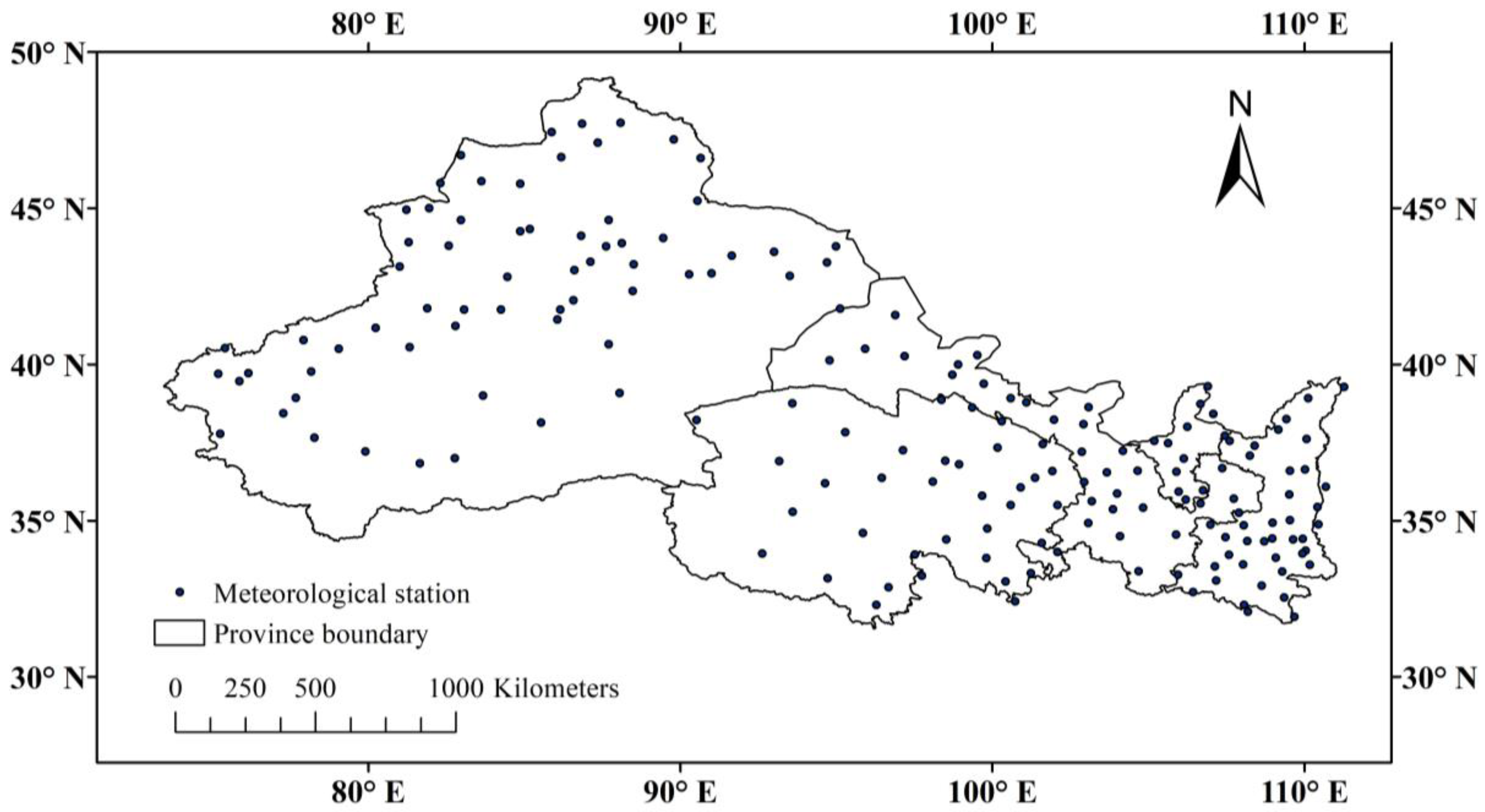
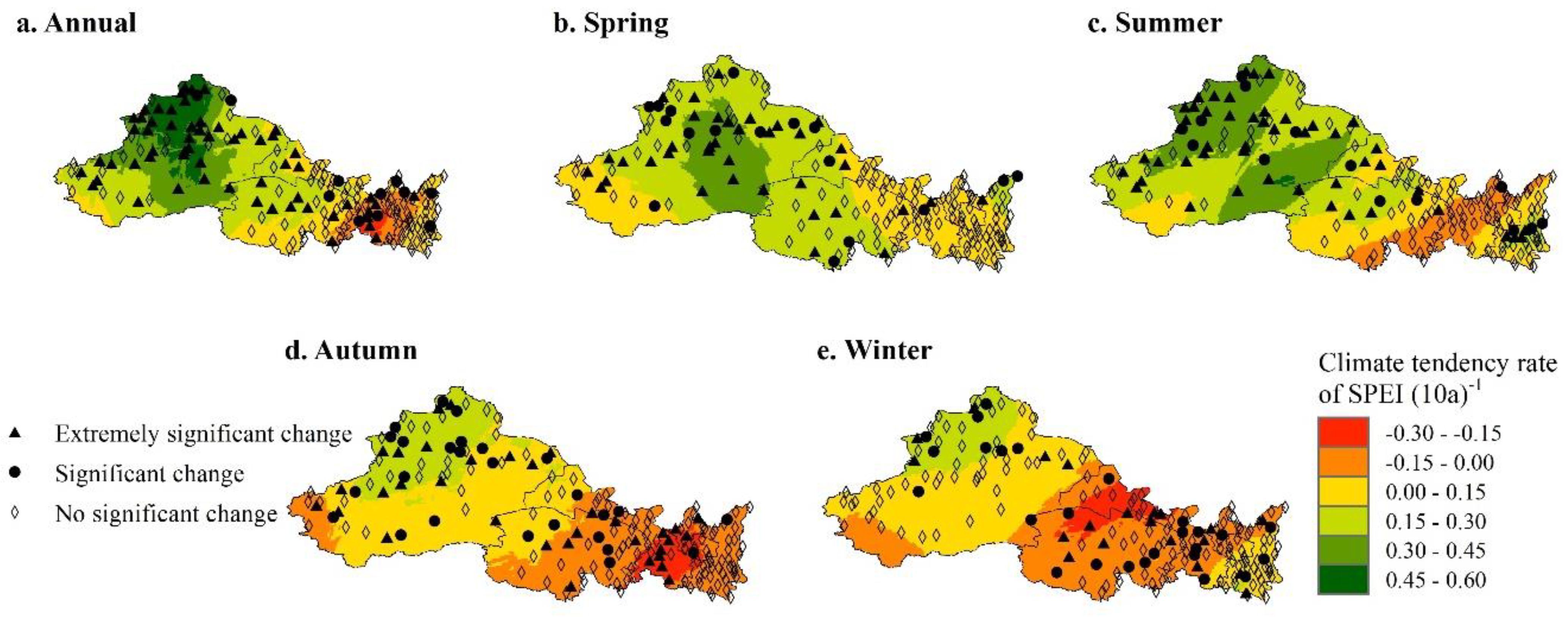
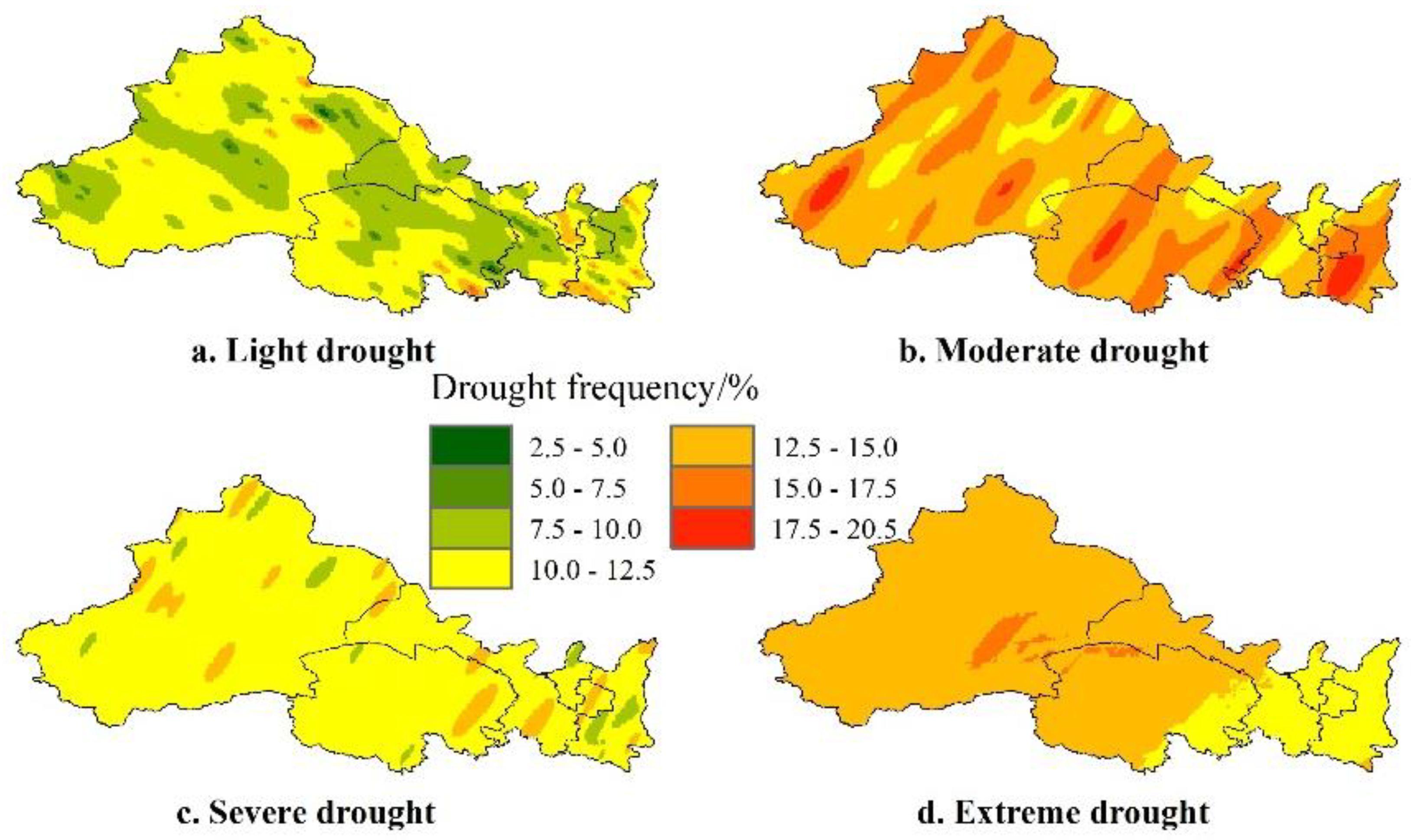

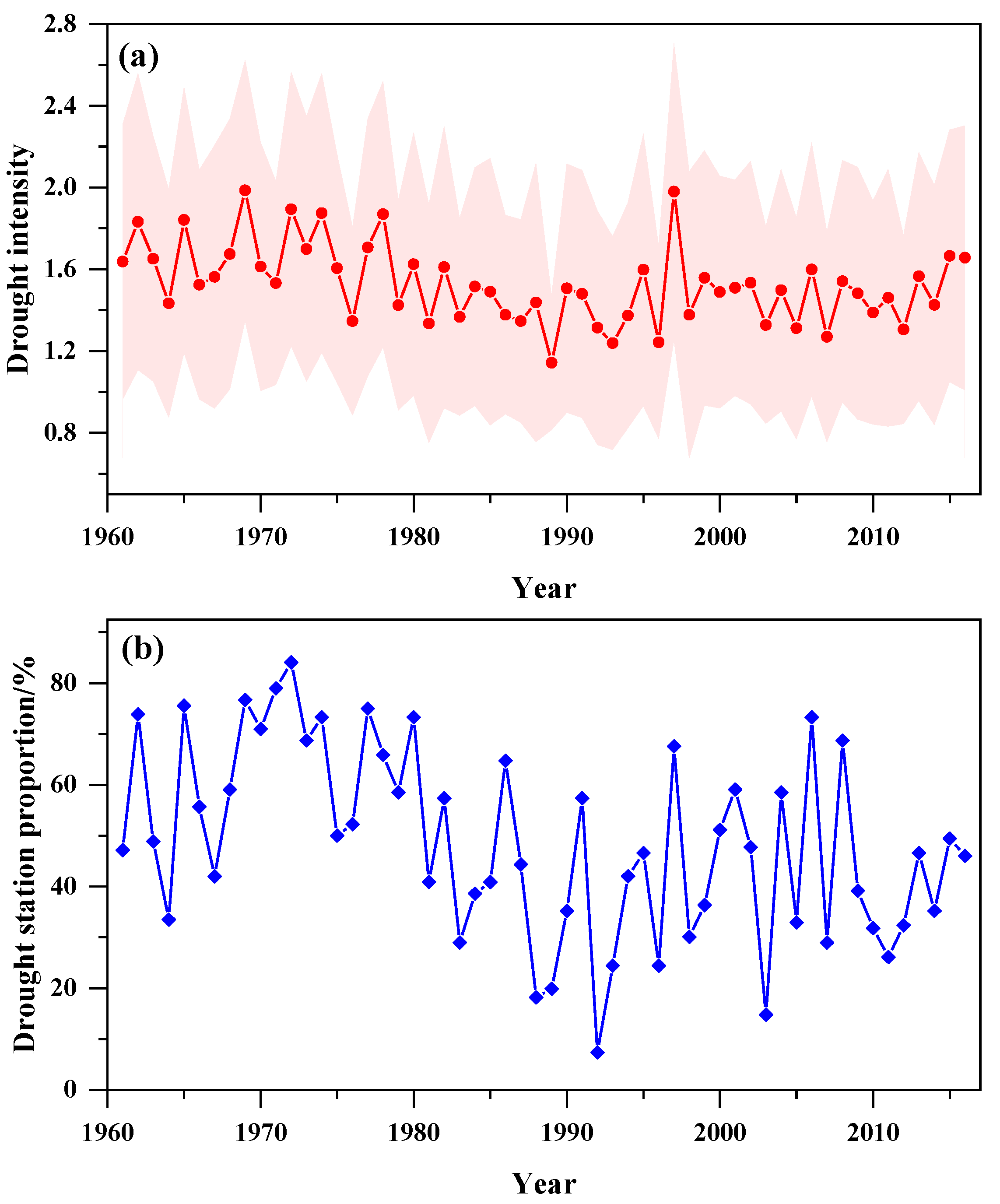
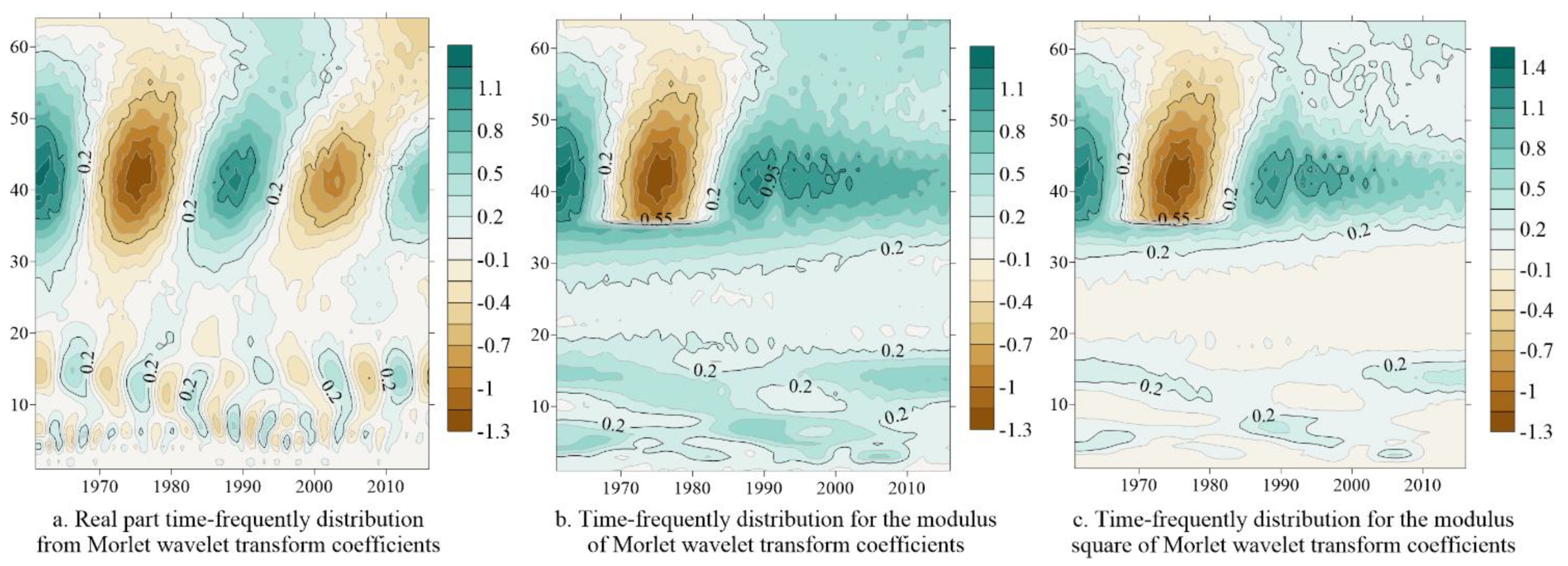

| Drought Intensity (Sij) | Drought Station Proportion (Pj) | ||
|---|---|---|---|
| Sij | Drought grade | Pj | Drought range |
| 2 ≤ Sij | Extreme drought | 50% ≤ Pj | Pan-regional drought |
| 1.5 ≤ Sij ≤ 2 | Severe drought | 33% ≤ Pj ≤ 50% | Regional drought |
| 1 ≤ Sij ≤ 1.5 | Moderate drought | 25% ≤ Pj ≤ 33% | Partial regional drought |
| 0.5 ≤ Sij ≤ 1 | Light drought | 10% ≤ Pj ≤ 25% | Local drought |
| 0.5 ≤ Sij | No drought | 10% ≤ Pj | Non-obvious drought |
Disclaimer/Publisher’s Note: The statements, opinions and data contained in all publications are solely those of the individual author(s) and contributor(s) and not of MDPI and/or the editor(s). MDPI and/or the editor(s) disclaim responsibility for any injury to people or property resulting from any ideas, methods, instructions or products referred to in the content. |
© 2023 by the authors. Licensee MDPI, Basel, Switzerland. This article is an open access article distributed under the terms and conditions of the Creative Commons Attribution (CC BY) license (https://creativecommons.org/licenses/by/4.0/).
Share and Cite
Peng, Y.; Peng, T.; Li, Y. Spatiotemporal Characteristics of Drought in Northwest China Based on SPEI Analysis. Atmosphere 2023, 14, 1188. https://doi.org/10.3390/atmos14071188
Peng Y, Peng T, Li Y. Spatiotemporal Characteristics of Drought in Northwest China Based on SPEI Analysis. Atmosphere. 2023; 14(7):1188. https://doi.org/10.3390/atmos14071188
Chicago/Turabian StylePeng, Yongqin, Tao Peng, and Yan Li. 2023. "Spatiotemporal Characteristics of Drought in Northwest China Based on SPEI Analysis" Atmosphere 14, no. 7: 1188. https://doi.org/10.3390/atmos14071188
APA StylePeng, Y., Peng, T., & Li, Y. (2023). Spatiotemporal Characteristics of Drought in Northwest China Based on SPEI Analysis. Atmosphere, 14(7), 1188. https://doi.org/10.3390/atmos14071188







